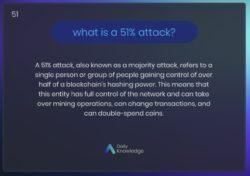The Ultimate Blockchain Quiz: 20 Questions to Test Your Knowledge

Blockchain technology has taken the world by storm, revolutionizing industries beyond cryptocurrency. Its decentralized, transparent, and secure nature has made it a hot topic in tech circles. Whether you’re a blockchain enthusiast, developer, or just curious, test your knowledge with these 20 blockchain quiz questions.
Top 20 blockchain quiz questions
Question 1: What Is Blockchain?
Answer: Blockchain is a decentralized and distributed digital ledger technology that records a chronological and immutable chain of transactions across a network of computers. Each group of transactions is stored in a “block,” and these blocks are linked together to form a “chain.” Blockchain is often associated with cryptocurrencies like Bitcoin, but its applications extend far beyond digital currencies. It offers transparency, security, and trust in a wide range of industries, from finance and supply chain to healthcare and voting systems.
Question 2: Who Is the Creator of Bitcoin?
Answer: The creator of Bitcoin is known by the pseudonym Satoshi Nakamoto. Satoshi Nakamoto published the Bitcoin whitepaper in 2008 and developed the initial Bitcoin software, releasing it to the world in 2009. However, Nakamoto’s true identity remains unknown, and they disappeared from public view in 2010, leaving the development of Bitcoin to the open-source community.

Question 3: What Is a Cryptocurrency Wallet?
Answer: A cryptocurrency wallet is a digital tool that allows users to store, manage, send, and receive cryptocurrencies securely. It stores the user’s private keys, which are essential for accessing and controlling their cryptocurrency holdings. Wallets come in various forms, including software wallets (online, desktop, or mobile applications), hardware wallets (physical devices), and paper wallets (physical documents with key information). Each wallet type offers different levels of security and convenience.
Question 4: What Is a Smart Contract?
Answer: A smart contract is a self-executing and self-enforcing piece of code that runs on a blockchain. It automatically executes, enforces, or manages the terms and conditions of an agreement or contract when predefined conditions are met. Smart contracts are tamper-proof, transparent, and trustless, making them valuable for a wide range of applications, including automated payments, supply chain management, and decentralized finance (DeFi) platforms.

Question 5: What Is Consensus Mechanism?
Answer: A consensus mechanism is a protocol or algorithm used in blockchain networks to ensure that all participants agree on the state of the blockchain. It prevents double-spending and maintains the integrity of the ledger. Common consensus mechanisms include Proof of Work (PoW), Proof of Stake (PoS), Delegated Proof of Stake (DPoS), and many others. Each mechanism has its own way of determining who gets to add new blocks to the blockchain and how network participants reach agreement on transactions.
Question 6: How Does Proof of Work (PoW) Work?
Answer: Proof of Work (PoW) is a consensus mechanism used in many blockchain networks, including Bitcoin. In PoW, miners compete to solve complex mathematical puzzles through computational work. The first miner to solve the puzzle gets the right to add a new block of transactions to the blockchain and is rewarded with cryptocurrency (e.g., Bitcoin). PoW is energy-intensive but has been proven to be a secure way to validate and add transactions to the blockchain.

Question 7: What Is a 51% Attack?
Answer: A 51% attack occurs when a single entity or group of miners gains control of more than 50% of the computational power (hashrate) on a blockchain network. With majority control, they can manipulate the blockchain by double-spending, excluding valid transactions, or even halting the network. This attack undermines the decentralization and security of the blockchain.

Question 8: What Is a Private Blockchain?
Answer: A private blockchain is a blockchain network where participation is restricted to authorized entities or participants. Unlike public blockchains like Bitcoin and Ethereum, which are open and permissionless, private blockchains are typically used for specific business or organizational purposes. They offer more control, privacy, and scalability but sacrifice some of the decentralization and transparency features of public blockchains.
Question 9: What Is Immutability in Blockchain?
Answer: Immutability in blockchain refers to the property that once data (transactions or blocks) is recorded on the blockchain, it cannot be altered, deleted, or tampered with. This property is essential for the trustworthiness of blockchain records and ensures that historical data remains unchanged over time, providing a transparent and tamper-resistant ledger.
Why an immutability in a blockchain system is a double-edged sword?🗡️
Shouldn’t the smart contracts stay as they are?
But what if there is a bug?🐛
In the following 🧵I will explain the following
• Why we need upgradability?
• What are the proxies?
• What is a DELEGATECALL?— Adrian ⛩️ Hetman 🐺⚔️ (@adrianhetman) June 29, 2022
Question 10: What Is a Cryptographic Hash Function?
Answer: A cryptographic hash function is a mathematical algorithm that takes an input (or message) and produces a fixed-size string of characters, known as a “hash value” or “digest.” The key properties of a good cryptographic hash function include collision resistance (two different inputs shouldn’t produce the same hash), preimage resistance (it’s computationally infeasible to reverse the hash to find the input), and avalanche effect (a small change in the input leads to a significantly different hash).
Question 11: What Is a Hard Fork?
Answer: A hard fork is a significant and often irreversible change to a blockchain’s protocol rules. It typically results in the creation of a new and separate blockchain that is incompatible with the previous version. Hard forks can occur due to disagreements among the blockchain’s community or developers about protocol changes. A well-known example is the hard fork that led to the creation of Bitcoin Cash (BCH) from Bitcoin (BTC).
Question 12: What Is the Role of a Node in a Blockchain Network?
Answer: A node in a blockchain network is a computer that participates in maintaining the network’s integrity and security. Nodes validate transactions, store a copy of the blockchain’s ledger, and relay information to other nodes. There are different types of nodes, including full nodes (which maintain a complete copy of the blockchain) and lightweight nodes (which rely on full nodes for transaction verification).
Question 13: What Is a Public Key and a Private Key in Cryptography?
Answer: In public-key cryptography (also known as asymmetric cryptography), a public key is a cryptographic key that is known to everyone. It is used for encrypting messages or data. A private key, on the other hand, is a secret key known only to the owner. It is used for decrypting messages or data encrypted with the corresponding public key. Public and private keys are paired, and data encrypted with one can only be decrypted with the other.
Question 14: What Is Double Spending in Blockchain?
Answer: Double spending is the act of using the same cryptocurrency tokens for multiple transactions. In traditional centralized systems, this is prevented by a central authority (like a bank) that ensures funds are not spent twice. In blockchain, double spending is prevented by the consensus mechanism, which validates and records transactions in a way that ensures each token can only be spent once.
Question 15: What Is Gas in Ethereum?
Answer: Gas is a unit of measurement for computational work on the Ethereum blockchain. Users pay gas fees to miners to compensate them for the computational resources required to execute operations or smart contracts. The gas fee varies depending on the complexity of the operation and the network’s congestion. It ensures that the Ethereum network remains secure and functional while preventing spam and inefficient code execution.
Question 16: What Is a Merkle Tree?
Answer: A Merkle tree (also known as a hash tree) is a data structure used in blockchain technology to efficiently verify the integrity of a large dataset, such as a block of transactions. It organizes data into a tree-like structure, with each leaf node representing a piece of data and each non-leaf node containing the hash of its child nodes. The top node, known as the “Merkle root,” is a single hash that summarizes the entire dataset. Verifying data integrity involves checking the Merkle root against the data.
Question 17: What Are Oracles in Blockchain?
Answer: Oracles are trusted third-party data sources or services that provide real-world information to smart contracts on a blockchain. Since blockchains are typically isolated from external data, oracles bridge the gap by feeding external data into smart contracts. They enable blockchain applications to interact with real-world events, such as stock prices, weather conditions, or sports scores, and make decisions based on this data.
Question 18: What Is the Purpose of a Block Explorer?
Answer: A block explorer is a web-based tool or interface that allows users to explore, search, and interact with a blockchain’s data. It provides transparency into a blockchain’s transactions, addresses, and block details. Users can view transaction histories, check the status of transactions, and track the movement of cryptocurrencies through the explorer.
Question 19: What Is Cross-Chain Communication?
Answer: Cross-chain communication refers to the ability of different blockchain networks to communicate and share data or assets with each other. It enables interoperability between separate blockchains, allowing assets or information to move seamlessly between different blockchain ecosystems. Cross-chain solutions aim to address the limitations of isolated blockchains and promote collaboration and asset exchange.
Question 20: What Is a Decentralized Autonomous Organization (DAO)?
Answer: A Decentralized Autonomous Organization (DAO) is an organization represented and governed by rules encoded as a computer program (smart contract) on a blockchain. DAOs operate transparently, without centralized control, and decisions are made through the consensus of their members who hold tokens representing voting power. DAOs are used for various purposes, including decentralized governance, investment, and decision-making in a decentralized manner.
These detailed answers should help you deepen your understanding of blockchain technology. Whether you’re new to the field or an experienced blockchain enthusiast, continuous learning is key in this rapidly evolving space. Keep exploring and expanding your blockchain knowledge!




























































